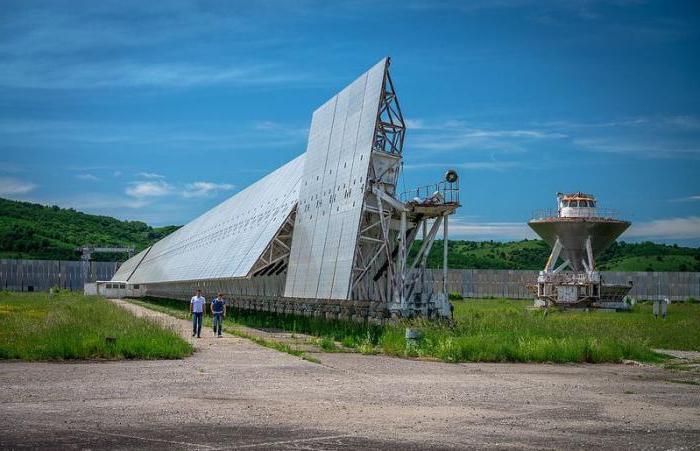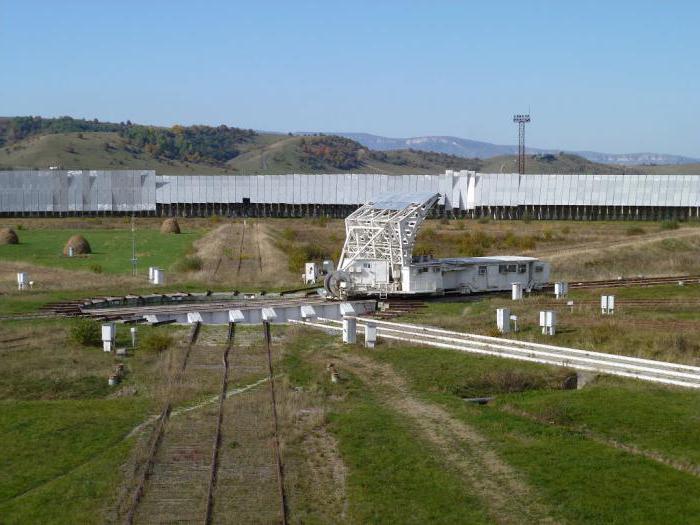The RATAN-600 is the largest radio telescope in the world located in Karachay-Cherkessia. The main mirror has a diameter of 576 meters, and the geometric area of the antennas is 15,000 m2. The telescope was created for the study of planets, the Sun, galaxies, extragalactic objects, spectral radiation and other purposes.

History: RATAN-600
The idea of building a domestic radio telescope onthe basis of the works of S. E. Khaikin and N. L. Kaidanovsky has been in the vital since the 50s. Initially, an experimental Pulkovo telescope was created, on the basis of which the effectiveness of variable-profile antennas for space research was proved.
It was the time of the Cold War, whenrivalry between the United States and the Soviet Union heated to the limit. The guide, inspired by the launch of the first satellite, required (to the delight of scientists) to consolidate the success of building grandiose objects for space exploration. They are the unique six-meter mirror azimuth telescope BTA and the radio telescope RATAN-600. The project was finally approved on August 18, 1965.
By the summer of 1974, the northern sector was commissioned.reflector and feed number 1. The first radio source PKS 0521-36 was investigated on July 12, 1974. By the beginning of 1977, the rest of the complex was introduced: a flat reflector, the southern, eastern and western sectors.

Description
RATAN-600 telescope is operated by Specialthe Astrophysical Observatory of the Russian Academy of Sciences (CAO), the only world-class observatory in the Russian Federation. The object is equipped with a 576-meter circular antenna (circular reflector), consisting of 895 elements. The size of each receiving element is 2 m wide and 11.4 m high.
From the total area of the object 15000 m2 the antenna itself (the outer part) takes up only 3,500 m2. The interior is an open space where emitters are placed, various devices that receive and analyze cosmic radiation.
Installed RATAN-600, whose photo is impressive,on the southern outskirts of Zelenchuk village (Karachay-Cherkessia). The village of the observatory, which includes laboratory buildings, residential buildings, a school, is located on the banks of the Bolshoi Zelenchuk river near the Nizhne-Arkhyz settlement for 9-13 centuries.

Specifications
In the device RATAN-600 used new principles of telescopes: altazimutalnaya mount, aperture synthesis and controlled surface. Main characteristics:
- Frequency range: 610-30000 MHz.
- Wave range: 1-50 cm.
- Accuracy: 1-10 angular seconds.
- Angular maximum resolution: 2 ang. seconds
- Limit of determination of brightness temperature: 0.050 mK.
- Limit of flux density determination: 0.500 mJy.
Thanks to the team of researchers who create and constantly improve these devices, the complex remains a key element in space observation.
Reception cabins
In addition to the circular reflector, collecting and concentrating information (radiation), RATAN is equipped with five receiving cabins. They are recording devices.
Cabins are placed on railway platforms, which allows them to be moved along 12 radial paths. Mobility provides research facilities at different azimuths in 30 ° increments.

Scientific work
The CAO implements a broad program of diverse research, including:
- A comprehensive study of solar activity in the radio.
- Astrometry with extreme angular resolution (speckle interferometry) of binary and multiple stars and individual stars with extended atmospheres.
- High-resolution spectroscopy of atmospheres and winds of stars of various types (in particular, the complex has become the main supplier of measurements of the magnetic fields of stars).
- Radio and optical spectroscopy of nebulae in our and other galaxies.
- Photometry with the limiting temporal resolution of relativistic objects (pulsars, black holes, and others).
- Photometry and spectroscopy of moderate and low resolution microquasars, gravitational lenses, normal and peculiar galaxies and individual stars in them.
- Building a spatial and kinematic picture of the local group of galaxies.
- Photometry and spectroscopy of optical components of gamma-ray bursts at cosmological distances.
- Radio mapping of the relic background of the universe.
RATAN-600 (Zelenchuk) has the status of toolsopen shared use. Along with domestic astronomers, a significant part of observational time is allocated to foreign colleagues, as a rule, for the implementation of joint projects.

Modernization
Over the years the existence of the CAO formed in ita unique team of instrument astronomers. Over the past decade, specialists have re-equipped the telescope with radiation receivers with high and constantly increasing characteristics: sensitivity, spectral, spatial and temporal resolution.
In particular, the drive technology has been re-equippedsecondary irradiators RATAN-600 and introduced an automated control system for positioning irradiators. Since 2008, a new version of the high-resolution solar spectral-polarization complex (SPKVR-2) has been operating.
To present the observations of the SunAn online resource has been developed that collects and analyzes data in real time. It has services for searching and analyzing data, including comparison with data from other tools, obtaining spectra and other parameters of local sources.
Work continues on the use of primaryirradiators with a single phase center, which allows you to “unload” the primary focus and conduct observations in the multi-frequency tracking mode (the Octave project for irradiators No. 1 and No. 3).
Work is underway to monitor and study external noise in the decimeter range, with the subsequent refinement of the receiving paths to protect against electromagnetic interference from radiometers in this range.

Prospective studies
CAO supervises research programs designed to shed light on the mysteries of the universe. Among the main projects:
- Sun Research.
- Structure and kinematics of interstellar gas in star-forming regions.
- The activity of sources of extragalactic radio emission.
- Search for relativistic jets in active galaxies and quasars.
- Investigation of the structure and kinematics of interstellar gas in star-forming regions.
- Studies of the spectra of extragalactic proto-objects.
- Cosmological gene.
- Observations on the MARS-3 Matrix radio-technical system.
- Long-wave observations of the object LSI + 61 303.
- Study of the spectra and variability of GPS sources.
- Simultaneous spectra of lazertids.
- Monitoring of microquasars.
Benefits
Among the advantages of the Russian telescope, experts point out:
- a large area without aberration field;
- multi-frequency measurements (0.6-35 GHz);
- increased resolution;
- sensitivity to brightness.
В ближайшие годы РАТАН станет еще лучше:The Russian Ministry of Education and Science in 2015 decided to allocate about 100 million rubles for the installation of mobile modules. If now the radio telescope observes objects located in direct visibility, then after the upgrade it will be able to accompany the target under study. This unique opportunity will expand the functionality of the complex.
Despite solid for difficult technicalobject age, RATAN-600 continues to be the largest radio telescope. He competes with the latest Chinese complex FAST with a 500-meter aperture.









